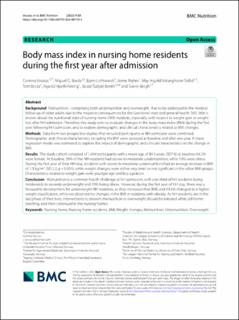| dc.contributor.author | Vossius, Corinna Elisabeth | |
| dc.contributor.author | Borda, Miguel Germán | |
| dc.contributor.author | Lichtwarck, Bjørn | |
| dc.contributor.author | Myhre, Janne | |
| dc.contributor.author | Sollid, May Ingvild Volungholen | |
| dc.contributor.author | Borza, Tom | |
| dc.contributor.author | Feiring, Ingvild Hjorth | |
| dc.contributor.author | Saltyte Benth, Jurate | |
| dc.contributor.author | Bergh, Sverre | |
| dc.date.accessioned | 2023-08-14T10:40:33Z | |
| dc.date.available | 2023-08-14T10:40:33Z | |
| dc.date.created | 2023-03-28T09:26:31Z | |
| dc.date.issued | 2023 | |
| dc.identifier.citation | BMC Nutrition. 2023, 9 (1), . | en_US |
| dc.identifier.issn | 2055-0928 | |
| dc.identifier.uri | https://hdl.handle.net/11250/3083765 | |
| dc.description.abstract | Background: Malnutrition - comprising both undernutrition and overweight - has to be addressed in the medical follow-up of older adults due to the negative consequences for the functional state and general health. Still, little is known about the nutritional state of nursing home (NH) residents, especially with respect to weight gain or weight loss after NH admission. Therefore, this study aims to evaluate changes in the body mass index (BMI) during the first year following NH admission, and to explore demographic and clinical characteristics related to BMI changes. Methods: Data from two prospective studies that recruited participants at NH admission were combined. Demographic and clinical characteristics including the BMI were assessed at baseline and after one year. A linear regression model was estimated to explore the impact of demographic and clinical characteristics on the change in BMI. Results: The study cohort consisted of 1,044 participants with a mean age of 84.3 years (SD7.6) at baseline; 64.2% were female. At baseline, 33% of the NH residents had severe to moderate undernutrition, while 10% were obese. During the first year of their NH stay, residents with severe to moderate undernutrition had an average increase in BMI of 1.3 kg/m2 (SD 2.2; p < 0.001), while weight changes were either very small or not significant in the other BMI groups. Characteristics related to weight gain were younger age and less agitation. Conclusion: Malnutrition is a common health challenge at NH admission, with one third of NH residents being moderately to severely underweight and 10% being obese. However, during the first year of NH stay, there was a favourable development for underweight NH residents, as they increased their BMI, and 43.6% changed to a higher weight classification, while we observed no changes in the BMI in residents with obesity. As NH residents are in the last phase of their lives, interventions to prevent malnutrition or overweight should be initiated while still home-dwelling, and then continued in the nursing homes. Keywords: BMI; Malnutrition; Nursing home; Nursing home residents; Overweight; Unternutrition; Weight changes. © 2023. The Author(s). | en_US |
| dc.language.iso | eng | en_US |
| dc.publisher | BMC | en_US |
| dc.rights | Navngivelse 4.0 Internasjonal | * |
| dc.rights.uri | http://creativecommons.org/licenses/by/4.0/deed.no | * |
| dc.title | Body mass index in nursing home residents during the first year after admission | en_US |
| dc.title.alternative | Body mass index in nursing home residents during the first year after admission | en_US |
| dc.type | Peer reviewed | en_US |
| dc.type | Journal article | en_US |
| dc.description.version | publishedVersion | en_US |
| dc.source.pagenumber | 9 | en_US |
| dc.source.volume | 9 | en_US |
| dc.source.journal | BMC Nutrition | en_US |
| dc.source.issue | 1 | en_US |
| dc.identifier.doi | 10.1186/s40795-023-00710-3 | |
| dc.identifier.cristin | 2137449 | |
| cristin.ispublished | true | |
| cristin.fulltext | original | |
| cristin.qualitycode | 1 | |

